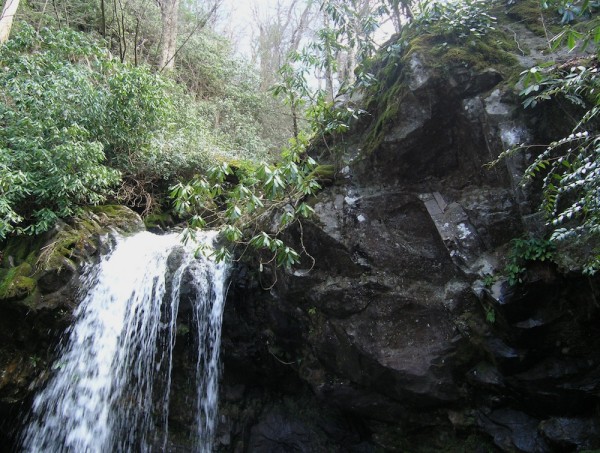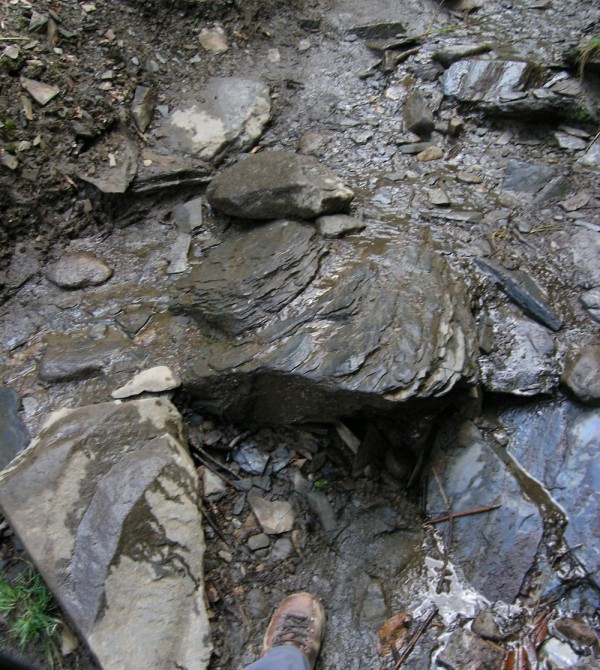![]() Earlier this year, I spent a pleasant day hiking in the Great Smoky Mountains National Park. One of the places I visited was Grotto Falls; not the world’s tallest waterfall, but rather handsome all the same.
Earlier this year, I spent a pleasant day hiking in the Great Smoky Mountains National Park. One of the places I visited was Grotto Falls; not the world’s tallest waterfall, but rather handsome all the same.
Being an unabashed geonerd, I took advantage of the fact that flowing water can helpfully exposed fresh, unweathered rock surfaces for me to peer at. The waterfall itself was flowing over a ledge of a hard grey rock which looked to be some kind of sandstone.
Fallen boulders along the river valley gave me a closer look, and confirmed that it was a sandstone, with a somewhat gritty texture (some of the larger sediment grains are a little too large to really be described as sand). It was actually quite crystalline, evidence that this sandstone that has been metamorphosed – its constituent minerals have been altered, and possibly new minerals have been produced, by exposure to high temperatures and pressures. As these rocks were caught up in the continental collision that raised the Great Smokies and the rest of the Appalachian mountain range between about 200 and 300 million years ago (I think that the rocks themselves in this region are between about 500 and 600 million years old), it’s hardly a surprise that they’ve been put through the geological wringer a bit.
Rock exposures underneath the waterfall were a little harder to come by, and when I finally found one I discovered why. Instead of a hard, unyielding metamorphosed sandstone – recrystallisation of quartz rich sandstone tends to meld all the grains together, making them extremely hard – there was mudstone that had been metamorphosed into slate. The inclusion of lots of clay minerals in the initial rock led to a much different lithological destiny: the growth of new minerals, all aligned in a similar way, has led to the development of internal layering known as cleavage. Whilst it may be one of those geological terms that has launched a thousand back-of-the-lecture-hall sniggers, it is actually rather usefully descriptive, as one consequence of the mineral alignment is that slates split apart very easily along these cleavage planes.
So: water is flowing over hard rock at the top of the waterfall, and over much weaker rock at its base. After a moment’s consideration it becomes fairly obvious that this change in rock type is precisely why Grotto Falls is there in the first place. The river is first flowing over sandstone that doesn’t erode very fast, and then over slate that does, and over time it cuts much faster and deeper into the latter part of the channel than the former. The fundamental control of geology on the topography of the stream is even more obvious if you look further downstream: Grotto Falls is merely the highest of a series of cascades along this river, and each time you find the river flowing over one of the harder sandstone layers in this sequence.
This sort of stuff is more my co-blogger’s area of expertise than mine, of course, but just like in last week’s Scenic Saturday, we find that that we are admiring a vista which began forming far further back in the geological past than you might think. The waterfall we see today is as much a product of environmental variations 500 million years ago, and deformation and metamorphism 250 million years ago, as it is of the last few hundreds and thousands of years of erosion.
Want to know more about metamorphism?
If you’re interested in learning more about metamorphism, you don’t need to go far: our latest all-geo blogger, Simon Welllings, graduated from Earth Science Erratics over the summer and is now writing at his very own blog, Metageologist, where he is currently writing an excellent series of posts on metamorphic rocks and how they form.








Comments (1)